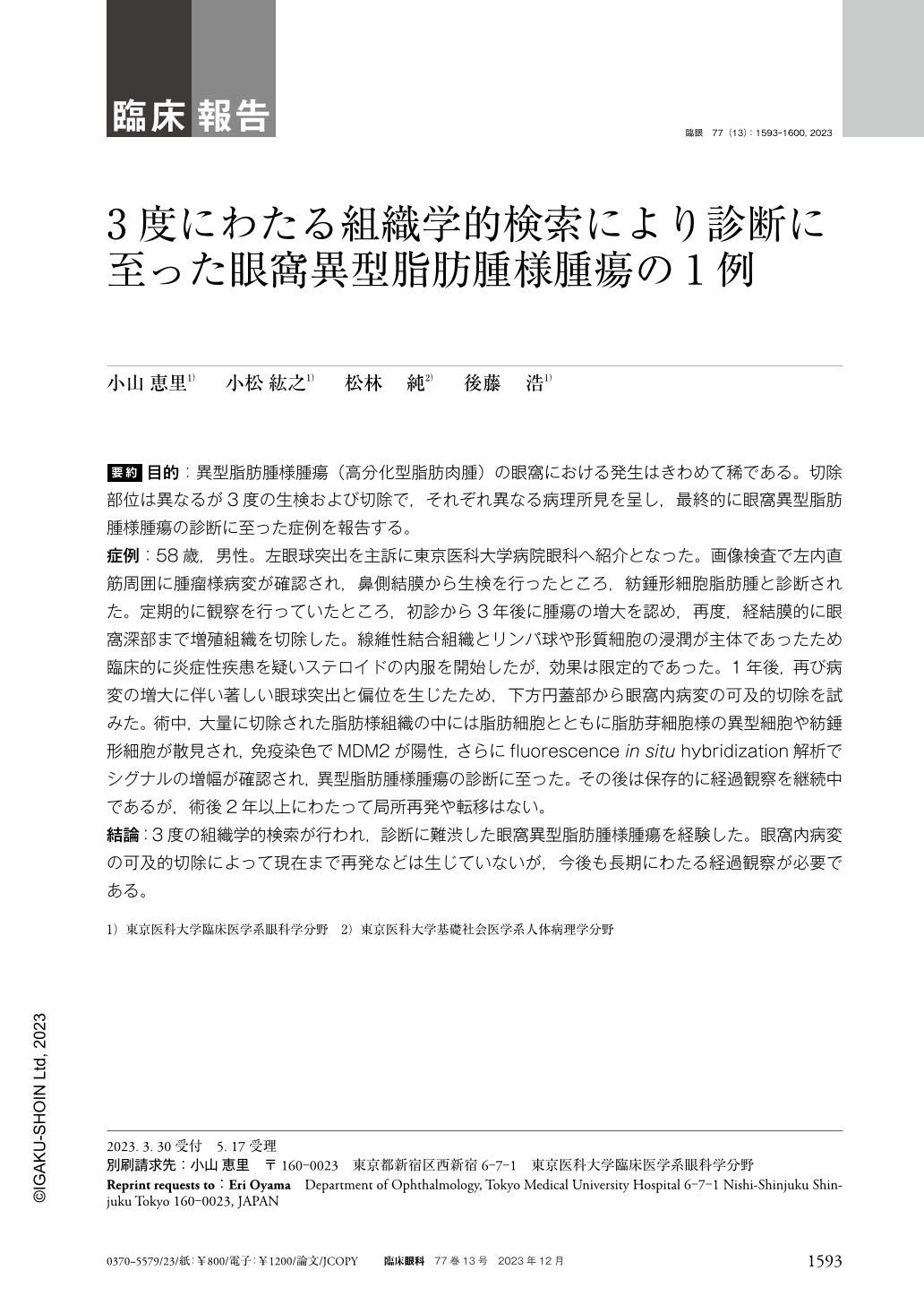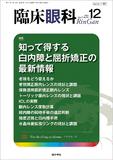Japanese
English
- 有料閲覧
- Abstract 文献概要
- 1ページ目 Look Inside
- 参考文献 Reference
要約 目的:異型脂肪腫様腫瘍(高分化型脂肪肉腫)の眼窩における発生はきわめて稀である。切除部位は異なるが3度の生検および切除で,それぞれ異なる病理所見を呈し,最終的に眼窩異型脂肪腫様腫瘍の診断に至った症例を報告する。
症例:58歳,男性。左眼球突出を主訴に東京医科大学病院眼科へ紹介となった。画像検査で左内直筋周囲に腫瘤様病変が確認され,鼻側結膜から生検を行ったところ,紡錘形細胞脂肪腫と診断された。定期的に観察を行っていたところ,初診から3年後に腫瘍の増大を認め,再度,経結膜的に眼窩深部まで増殖組織を切除した。線維性結合組織とリンパ球や形質細胞の浸潤が主体であったため臨床的に炎症性疾患を疑いステロイドの内服を開始したが,効果は限定的であった。1年後,再び病変の増大に伴い著しい眼球突出と偏位を生じたため,下方円蓋部から眼窩内病変の可及的切除を試みた。術中,大量に切除された脂肪様組織の中には脂肪細胞とともに脂肪芽細胞様の異型細胞や紡錘形細胞が散見され,免疫染色でMDM2が陽性,さらにfluorescence in situ hybridization解析でシグナルの増幅が確認され,異型脂肪腫様腫瘍の診断に至った。その後は保存的に経過観察を継続中であるが,術後2年以上にわたって局所再発や転移はない。
結論:3度の組織学的検索が行われ,診断に難渋した眼窩異型脂肪腫様腫瘍を経験した。眼窩内病変の可及的切除によって現在まで再発などは生じていないが,今後も長期にわたる経過観察が必要である。
Abstract Purpose:Atypical lipomatous tumor(well differentiated liposarcoma)of the orbit is extremely rare. We report a case of orbital atypical lipomatous tumor diagnosed after three biopsy or excision procedures, each of which revealed different pathological findings.
Case:A 58-year-old man with a chief complaint of proptosis of the left eye was referred to the Department of Ophthalmology, Tokyo Medical University Hospital. Imaging revealed a mass lesion along the inner rectus muscle. A biopsy was performed at the nasal conjunctiva, resulting in a histopathological diagnosis of spindle cell lipoma. After 3 years of regular follow-up, enlargement of the residual mass was observed. Transconjunctival excision of the proliferated tissue was performed well-differentiated up to the deep orbit. Histopathological examination revealed of the biopsy were lymphoplasmacytic infiltration. Oral corticosteroid therapy was started, but the clinical response was limited. One year later, further enlargement of the intraorbital lesion resulted in marked proptosis and deviation of the left eye. We attempted to excise as much of the intraorbital lesion as possible via the inferior fornix. A large quantity of adipose-like tissue was excised. Histopathological examination revealed lipoblast-like atypical cells and spindle cells scattered in the adipose tissue. Additionally, immunohistochemical staining revealed MDM2 positivity, and MDM2 gene amplification was confirmed by fluorescence in situ hybridization, leading to the final diagnosis of atypical lipomatous tumor. The patient has been under follow-up, and no recurrence and metastasis have been observed over 3 years.
Conclusions:We report a case of atypical lipomatous tumor arising in the orbit, which was diagnosed after three histopathological studies of biopsied and excised tissues. Although no recurrence was observed after subtotal excision, long-term follow-up is necessary.

Copyright © 2023, Igaku-Shoin Ltd. All rights reserved.


